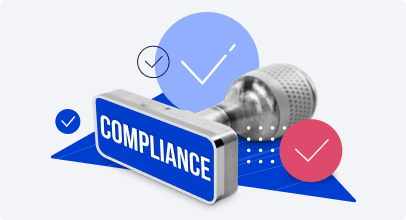Data Security Training: Protecting Your Company’s Data and Reputation

Because data is every company’s greatest asset, its protection is core to any business’s success and survival. When we think of data security breaches, what usually comes to mind is corporate espionage or illegal hacking by cybercriminals. In defense, businesses often hold down the fort by focusing on the technology side of the solution. But technology hardly guards against the far more insidious and pervasive cause of company data breaches – employee error.
According to Cybint, human error accounts for a whopping 95% of all cybersecurity breaches. That’s why the best data security approaches are multi-layered. They not only include some combination of anti-malware software, firewalls, and VPNs, but also data security training to address the human risk factor.
In this article, we’ll explain what data security training should include and how to create an online data security course on your own.
What Is Data Security Training?
Data security training educates employees on best practices that protect data from loss, modification, or theft. Since data security can be compromised either by mistake or intentionally, training should focus both on accidental data mishandling and protection from malicious attempts.
With modern technologies, you can train your employees online so your staff can learn at their own pace and from any device. You can create eLearning courses on data security and share them with your learners on the Internet. For example, you can build linear slide-based courses with a final quiz, dialogue simulations, or interactive modules with a branching scenario. You can choose any format depending on your training needs and the results you want to achieve.
What to Include in Data Security Training
To arm your employees, you’ll need to enforce a strict culture of data privacy training and put its principles at the core of your company’s culture. You can’t prevent what you don’t recognize. Therefore, to address this gap, privacy and security training topics include defining, recognizing, and responding to existing types of attacks (phishing, malware, malicious/negligent insiders, etc.).
Moreover, it aims to prevent the loss, destruction, alteration, exploitation, or disclosure of sensitive company data. And because these privacy and security breaches can be caused either deliberately or unintentionally, it outlines strict measures to handle data and thwart malicious activity appropriately.
That said, there’s a minor distinction to note between cybersecurity and privacy awareness training. Cybersecurity training is more of a narrow term, since it focuses solely on that which is within cyberspace. But privacy awareness training recognizes that companies store data both on and offline, such as paper records/documents.
This list briefly outlines 8 of the most relevant and pertinent topics based on today’s cyber and data security landscape.
Phishing attacks

The phishing attack is one of the most important topics to cover. Because they masquerade as urgent and/or incentivizing emails – often from ‘recognizable’ companies – employees should learn how to identify phishing emails and put security measures in place (e.g., spam filters, avoiding unknown links, ignoring unsolicited emails, etc.).
Malicious software

Malicious software, or “malware,” is a catchall term for the various types of software hackers use to steal sensitive data, wreck your network and data systems, or some combination thereof (phishing bots included). Thus, your data privacy training courses should distinctly detail what constitutes unauthorized software, and why and how to keep your anti-malware software updated, etc.
Password security

Password security is a no-brainer topic to cover. Most companies require employees to log in to a variety of systems for user permission authentication. As such, this topic outlines how to create a virtually uncrackable passcode. It includes measures such as using a different password for each account, as well as incorporating a wide range of characters (lowercase/uppercase letters, numbers, symbols, etc.).
Secure browsing habits

Secure browsing habits are paramount for any business that gives its employees internet access. But even the simple act of browsing opens your business up to a world of cyberattacks and data breaches if they lack proper awareness. As such, this topic includes identifying spoofed domains, ensuring the URL is prefaced with the encrypted HTTPS vs. unencrypted HTTP protocol, and remaining vigilant about the source and developer of your download file.
Workplace social media policy

Whether it’s restricting employee access to personal social media, or navigating social media for branding purposes, social cyberspace has also been infiltrated by malicious actors. Hackers love phishing with convincing tactics like Facebook friend requests or LinkedIn invites. They can hack into business pages and profiles, steal information, and use this to manipulate any of your followers, friends, or connections, among many other techniques.
Data management and privacy

Data management and privacy is an essential topic to cover, especially as related to confidentiality training for employees. Given the intellectual property that businesses work with, as well as sensitive employee and customer data, this training topic discusses how to securely collect, handle, store, and retrieve such information in detail. This topic acquaints employees with relevant regulatory requirements and company compliance frameworks to execute data management and confidentiality properly.
Environmental security controls

As mentioned, rather than focusing on data stored in cyberspace (as with cybersecurity training), data security training covers a far broader scope that further encompasses the physical work environment and any sensitive data/documents stored within it. It also includes who is present in the environment.
As such, privacy training for employees covers how to verify the identity of third-party contractors or visitors in order to avoid impersonation and unauthorized access to data systems, guard against shoulder surfing while typing in passwords, and log out of or shut down all systems after use.
Clear desk policy

Speaking of environmental controls, other training topics include a “clear desk policy.” If your employees work in an office setting and use work aids like post-its, printouts, and paper documents containing confidential information that can be seen by preying or prying eyes, then your employees inadvertently place you at dire risk of data breaches.
Privacy and security training that highlights the importance of clearing your desk whenever you’re away from it, such as during break or after work, will ensure that employees keep visible only that which is currently and absolutely necessary.
How to Create Data Security Training
As mentioned, one way to provide data security training is to do this online. For example, you can create an eLearning course on potential security risks and ways to protect vital data and information, share it with your entire staff, and verify if they’ve retained it well.
Here’s a demo course on data security training that we created.
As you can see, it’s a cyberattack simulation with drill and practice activities. We’ve used quizzes and detailed feedback to help learners understand and remember how to protect personal data. More specifically, a learner is shown various examples of emails, websites, and mobile apps and needs to identify which of them are safe and which are malicious.
Now, we’ll show you how we assembled this course step by step.
Step 1. Install an authoring tool
To build a course, you need an eLearning authoring tool. There are, in fact, many such tools on the market, different in the type of output content, approach to course creation, and level of complexity. Some tools may require several months to master, but there are also apps that can be easily leveraged even if you’re not a tech geek.
We’ve created the course with iSpring Suite. This is an easy-to-use authoring tool that allows you to build courses right in PowerPoint and then turn them into an eLearning format. You can download it for free to assemble your first course right now.
Download iSpring Suite 14-day trial →
After you install it on your computer, iSpring Suite will appear as a new tab in the PowerPoint ribbon:

Step 2. Define your learning goals and objectives
An important thing you need to do when creating an online course is to establish its goal. This is about what “global” result you want to get after your employees complete an online course. After you formulate a goal, you can split it into a few learning objectives. Think about exactly what your learners should be able to do after completing the training. Here’s how we did it for our course:

Step 3. Plot your course
In this step, you need to create an outline of your course. In fact, it’s very easy if you’ve set up the learning objectives correctly. Keeping the objectives in mind, simply divide your course into respective training modules as in the example below:

So, we decided that our course would consist of three modules. Going forward, later at the content authoring stage, we’ll create a so-called course map slide that will unite all three modules of a course and serve as a navigation slide that lets learners move between the modules. This is how it will look as a result:

Step 4. Create a course storyboard
Now that you have established the structure of your course, you can start mapping out the course or “create a storyboard.” This is a document that serves as the course blueprint and outlines the text, visuals, interactions, navigation and other elements that will be used in the eLearning course. A storyboard can be created by means of various tools; for example, it can be a Word file, a PowerPoint slide deck, or a Miro board.

Here’s what you might want to include in your storyboard:
- Slide title/name
- Screen text and elements
- Audio and video instructions
- Graphic instructions
- Interactivity and navigation
Step 5. Write a script
After you have an idea of what each slide will be about, you need to write a script, which is the text your learners will see on the slides. Here are a few tips on how to do this correctly:
- Add only key information. If you want to provide more details, you can record a voice over or support the text with media.
- Keep the text short. Long paragraphs with complex sentences can make writing difficult to follow. So remove unnecessary words, break down long sentences, and, most importantly, stick to the “one screen, one idea” rule.

- Keep it simple and conversational. Use simple language that’s easy to follow, as though you’re speaking directly to your employees. A friendly tone works best, but refrain from being overly chatty.
In our case, we need not only to write a text for the slides but also add detailed feedback for correct and incorrect answers. This will help learners retain the information much better.

Step 6. Decide on course design
Now that your storyboard and script are ready, it’s time to think about the design of your course. If your company has a brand book, it’ll be much easier for you. A so-called brand book or a brand style guide provides distinct guidelines for maintaining brand identity across all aspects of the business, including employee training.
Some things that are generally included in a brand book include:
- Font and font sizes
- Color and branding guidelines
- Image placements and dimensions
- Image formats and resolutions
- Use of tone, language, and more
Style guides can be formatted as Word documents, created as PowerPoint slides, or presented as a kit in Figma, as in the example below:

If you don’t have a brand style guide, you can create it on your own. Define a palette of colors, fonts, and decide which icons you will use. This way you’ll achieve design consistency and your course will look professional.
Step 7. Prepare graphics and media
The next step is to assemble all of the content. Find all the necessary graphics that match your design style and videos. Record a voice over, if needed.
For our demo course, we need to create screenshots of safe and malicious emails, websites, and mobile apps.

Step 8. Author your course
After you have all the necessary content, you just need to add it to your authoring tool. We’ve assembled a course with the abovementioned iSpring Suite. Building a course with iSpring is the same as creating a PowerPoint presentation: add a new slide, type in the text, add images or video, and repeat.
As previously mentioned, we also used quizzes and detailed feedback to build a simulation. We’ve chosen simple multiple-choice questions. A learner needs to select between two options, as in this example:

After an employee gives an answer, they get customized feedback, depending on whether the response is correct or incorrect.
We’ve also added a hotspot question at the beginning of the course and use it as an icebreaker to engage learners.

Step 9. Share the course with your employees
The easiest and most convenient way to deliver a course to all your employees is via a learning management system (LMS). It will let your employees view a course online whenever they need it from any device they want and allow training professionals to automate many of the steps required for learning delivery, such as scheduling, sending out invites, registering learners, and collecting results. If you still don’t have an LMS, you can try iSpring Learn.
How to Evaluate the Effectiveness of Your Data Privacy Training
Now that you’ve created your data privacy training course, the final phase is ensuring that it’s effective. To that end, you should view this final “phase” as more of an ongoing process. Ultimately, any privacy and security training worth its salt not only complies with strict regulations but also demonstrates a shift in company culture towards enhanced data protection.
Helpful metrics to see if your privacy awareness training is pulling its weight include:
- Course completion rates. To show compliance with training frequency requirements, you’ll need an LMS that delivers and monitors trainee progress and can generate automatic reports that verify completion. Accompanied with assessment scores, these completion reports give empirical insight into trainee comprehension.
- Trainee engagement. In addition to distributing course feedback surveys, you can track trainee engagement levels to measure their engagement. The more engagement, the more likely training will lead to sustained behavioral change and leave a lasting impact on company culture. The best LMS reporting systems provide engagement metrics that demonstrate how much trainees are willing to interact with content – especially supplementary training materials (e.g., email open rates, video view counts, newsletters).
- Incident reporting systems. Though the aim is to generally avoid incidents, it’s impossible to divorce how efficient your reporting systems are from your training’s overall effectiveness. There are countless “incident management software” to choose from; they enable employees to log, prioritize, diagnose, escalate, investigate, and resolve incidents – in that order.
Employees can then use such incident-related data to scan for patterns, before and after effects, as well as give insights about whether data incidents are increasing or decreasing. Note that an increase in incidents might indicate finer-tuned eyes for data privacy and security risks.
Final Thoughts
When it comes to considering the cost of data and reputational loss versus data security training, the question isn’t “Why?” but “How?” Fortunately, in this guide, we’ve provided you with key topics and 9 crucial steps to create an effective cybersecurity course.











